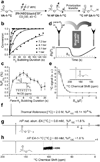Efficient Synthesis of Molecular Precursors for Para-Hydrogen-Induced Polarization of Ethyl Acetate-1-(13) C and Beyond
- PMID: 27061815
- PMCID: PMC4939483
- DOI: 10.1002/anie.201600521
Efficient Synthesis of Molecular Precursors for Para-Hydrogen-Induced Polarization of Ethyl Acetate-1-(13) C and Beyond
Abstract
A scalable and versatile methodology for production of vinylated carboxylic compounds with (13) C isotopic label in C1 position is described. It allowed synthesis of vinyl acetate-1-(13) C, which is a precursor for preparation of (13) C hyperpolarized ethyl acetate-1-(13) C, which provides a convenient vehicle for potential in vivo delivery of hyperpolarized acetate to probe metabolism in living organisms. Kinetics of vinyl acetate molecular hydrogenation and polarization transfer from para-hydrogen to (13) C via magnetic field cycling were investigated. Nascent proton nuclear spin polarization (%PH ) of ca. 3.3 % and carbon-13 polarization (%P13C ) of ca. 1.8 % were achieved in ethyl acetate utilizing 50 % para-hydrogen corresponding to ca. 50 % polarization transfer efficiency. The use of nearly 100% para-hydrogen and the improvements of %PH of para-hydrogen-nascent protons may enable production of (13) C hyperpolarized contrast agents with %P13C of 20-50 % in seconds using this chemistry.
Keywords: MRI; contrast agents; ethyl acetate; hyperpolarization; para-hydrogen induced polarization (PHIP).
© 2016 WILEY-VCH Verlag GmbH & Co. KGaA, Weinheim.
Figures



References
-
- Kurhanewicz J, Vigneron DB, Brindle K, Chekmenev EY, Comment A, Cunningham CH, DeBerardinis RJ, Green GG, Leach MO, Rajan SS, Rizi RR, Ross BD, Warren WS, Malloy CR. Neoplasia. 2011;13:81–97. - PMC - PubMed
- Brindle KM. J. Am. Chem. Soc. 2015;137:6418–6427. - PubMed
- Comment A, Merritt ME. Biochemistry. 2014;53:7333–7357. - PMC - PubMed
- Golman K, in't Zandt R, Thaning M. Proc. Natl. Acad. Sci. U. S. A. 2006;103:11270–11275. - PMC - PubMed
- Bhattacharya P, Chekmenev EY, Perman WH, Harris KC, Lin AP, Norton VA, Tan CT, Ross BD, Weitekamp DP. J. Magn. Reson. 2007;186:150–155. - PMC - PubMed
-
- Nelson SJ, Kurhanewicz J, Vigneron DB, Larson PEZ, Harzstark AL, Ferrone M, van Criekinge M, Chang JW, Bok R, Park I, Reed G, Carvajal L, Small EJ, Munster P, Weinberg VK, Ardenkjaer-Larsen JH, Chen AP, Hurd RE, Odegardstuen LI, Robb FJ, Tropp J, Murray JA. Sci. Transl. Med. 2013;5:198ra108. - PMC - PubMed
-
- Bowers CR, Weitekamp DP. Phys. Rev. Lett. 1986;57:2645–2648. - PubMed
- Eisenschmid TC, Kirss RU, Deutsch PP, Hommeltoft SI, Eisenberg R, Bargon J, Lawler RG, Balch AL. J. Am. Chem. Soc. 1987;109:8089–8091.
- Bowers CR, Weitekamp DP. J. Am. Chem. Soc. 1987;109:5541–5542.
Publication types
MeSH terms
Substances
Grants and funding
LinkOut - more resources
Full Text Sources
Other Literature Sources
Miscellaneous

